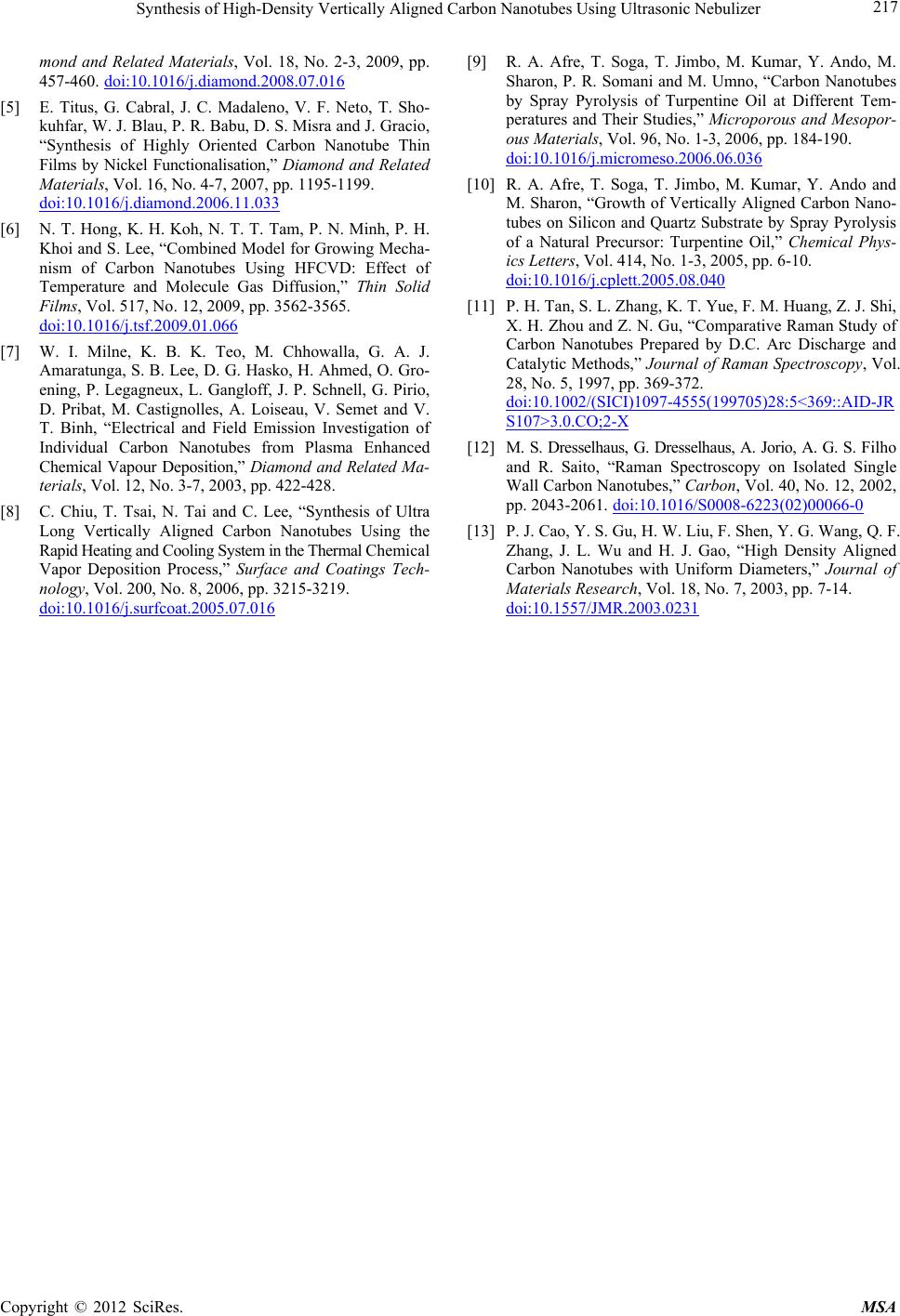
Synthesis of High-Density Vertically Aligned Carbon Nanotubes Using Ultrasonic Nebulizer
Copyright © 2012 SciRes. MSA
217
mond and Related Materials, Vol. 18, No. 2-3, 2009, pp.
457-460. doi:10.1016/j.diamond.2008.07.016
[5] E. Titus, G. Cabral, J. C. Madaleno, V. F. Neto, T. Sho-
kuhfar, W. J. Blau, P. R. Babu, D. S. Misra and J. Gracio,
“Synthesis of Highly Oriented Carbon Nanotube Thin
Films by Nickel Functionalisation,” Diamond and Related
Materials, Vol. 16, No. 4-7, 2007, pp. 1195-1199.
doi:10.1016/j.diamond.2006.11.033
[6] N. T. Hong, K. H. Koh, N. T. T. Tam, P. N. Minh, P. H.
Khoi and S. Lee, “Combined Model for Growing Mecha-
nism of Carbon Nanotubes Using HFCVD: Effect of
Temperature and Molecule Gas Diffusion,” Thin Solid
Films, Vol. 517, No. 12, 2009, pp. 3562-3565.
doi:10.1016/j.tsf.2009.01.066
[7] W. I. Milne, K. B. K. Teo, M. Chhowalla, G. A. J.
Amaratunga, S. B. Lee, D. G. Hasko, H. Ahmed, O. Gro-
ening, P. Legagneux, L. Gangloff, J. P. Schnell, G. Pirio,
D. Pribat, M. Castignolles, A. Loiseau, V. Semet and V.
T. Binh, “Electrical and Field Emission Investigation of
Individual Carbon Nanotubes from Plasma Enhanced
Chemical Vapour Deposition,” Diamond and Related Ma-
terials, Vol. 12, No. 3-7, 2003, pp. 422-428.
[8] C. Chiu, T. Tsai, N. Tai and C. Lee, “Synthesis of Ultra
Long Vertically Aligned Carbon Nanotubes Using the
Rapid Heating and Cooling System in the Thermal Chemical
Vapor Deposition Process,” Surface and Coatings Tech-
nology, Vol. 200, No. 8, 2006, pp. 3215-3219.
doi:10.1016/j.surfcoat.2005.07.016
[9] R. A. Afre, T. Soga, T. Jimbo, M. Kumar, Y. Ando, M.
Sharon, P. R. Somani and M. Umno, “Carbon Nanotubes
by Spray Pyrolysis of Turpentine Oil at Different Tem-
peratures and Their Studies,” Microporous and Mesopor-
ous Materials, Vol. 96, No. 1-3, 2006, pp. 184-190.
doi:10.1016/j.micromeso.2006.06.036
[10] R. A. Afre, T. Soga, T. Jimbo, M. Kumar, Y. Ando and
M. Sharon, “Growth of Vertically Aligned Carbon Nano-
tubes on Silicon and Quartz Substrate by Spray Pyrolysis
of a Natural Precursor: Turpentine Oil,” Chemical Phys-
ics Letters, Vol. 414, No. 1-3, 2005, pp. 6-10.
doi:10.1016/j.cplett.2005.08.040
[11] P. H. Tan, S. L. Zhang, K. T. Yue, F. M. Huang, Z. J. Shi,
X. H. Zhou and Z. N. Gu, “Comparative Raman Study of
Carbon Nanotubes Prepared by D.C. Arc Discharge and
Catalytic Me thods,” Journal of Raman Spectroscopy, Vol.
28, No. 5, 1997, pp. 369-372.
doi:10.1002/(SICI)1097-4555(199705)28:5<369::AID-JR
S107>3.0.CO;2-X
[12] M. S. Dresselhaus, G. Dresselhaus, A. Jorio, A. G. S. Fil ho
and R. Saito, “Raman Spectroscopy on Isolated Single
Wall Carbon Nanotubes,” Carbon, Vol. 40, No. 12, 2002,
pp. 2043-2061. doi:10.1016/S0008-6223(02)00066-0
[13] P. J. Cao, Y. S. Gu, H. W. Liu, F. Shen, Y. G. Wang, Q. F.
Zhang, J. L. Wu and H. J. Gao, “High Density Aligned
Carbon Nanotubes with Uniform Diameters,” Journal of
Materials Research, Vol. 18, No. 7, 2003, pp. 7-14.
doi:10.1557/JMR.2003.0231